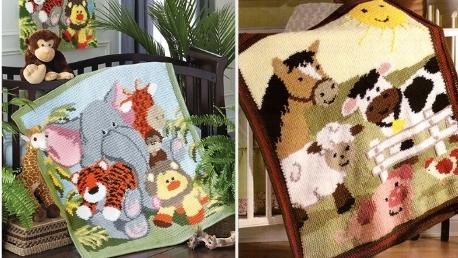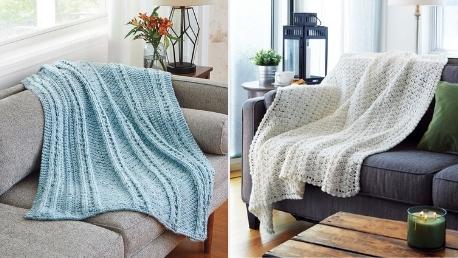Hats are one of the most common projects that people knit. They are quick and easy to make and can be very practical. Hats can be made in a variety of different styles — whether you want a warm and cozy hat for the winter or a light and airy hat for the summer, you can find a pattern that will work for you.
If you’re a beginner who’s ready to knit your own hat, you’ve come to the right place. Here, we give you a complete step-by-step tutorial on hat knitting.
Learn How to Knit a Hat: Step-by-Step Tutorial for Beginners!
Hats can be made in all sorts of shapes, sizes, and styles, making them ideal for both beginners and experienced knitters alike. If you're new to knitting, though, there are a few things you should keep in mind before you start your first hat project.
First, you'll need to choose the right yarn. Hats are typically knit with worsted weight yarn such as Caron Simply soft 4-ply worsted weight yarn, or Patons Canadiana Yarn The New generation which are medium weight yarns that are not too thick or too thin. You'll also want to ensure you have enough yarn to complete your project; most hats use between 100 and 200 yards of yarn.
Next, you'll need to choose the right needles. You'll typically need circular needles, which are long needles that are joined together at the ends. The size of the needle you'll need will depend on your yarn. For most worsted weight yarns, you should use US sizes 8 or 9 needles.
Finally, you'll need to know a few basic hat-making techniques. These include casting on, knitting in the round, and decreasing. If you're not familiar with these techniques, don't worry. We provide you with a step-by-step guide below. Let's jump right in.
Materials You'll Need
- A skein of worsted weight yarn
- A pair of size 8 US knitting needles (or whatever size needle is recommended on the yarn label)
- A tapestry needle
- Pom-pom embellishments
- Scissors
- Stitch marker (optional)
Step 1: Cast On the Stitches
There are a few different ways that you can cast on the stitches when knitting a hat. The most common way is to use the long-tail cast-on method. This method is relatively easy to do and results in a nice, tight edge on your hat.
To begin, you'll need pull out a generous portion of yarn, about a yard or so and place a slip knot. If you's like to be precise, we recommend casting on about 10 stitches and measuring how much yarn you used then multiplying that by how many tens of stitches you'll need to cast on. Many times you'll get it right by overestimating the amount of yarn you'll need to cast on. It may take sometime before your estimations become accurate.
Next, take the tail of the yarn in your left hand and hold the needle in your right hand. Insert the needle into the loop of yarn on your left thumb, making sure that the yarn is wrapped around your thumb from back to front.
Now, use the needle to grab the yarn that's wrapped around your left thumb and pull it through the loop.This should make you two loops on your needle.
Next, take the yarn off of your left thumb and insert the needle into the first loop on the needle (the one closest to the tip). Now, use the needle to grab the yarn that's wrapped around your left index finger and pull it through the loop.This should make you three loops on your needle.
Repeat this process, moving from left to right, until you have the desired number of stitches on your needle. Once you've cast on all of your stitches, you're ready to start knitting! Take a look at our video tutorial on how to make a long tail cast on.
Step 2: Knit the Brim & Ribbing
When you're knitting a hat, ribbing is one of the most important parts. The brim adds elasticity to your fabric ensuring your hat will stay where it is intended. You always want to make sure the finished size is smaller than your head. If your ribbing doesn't stretch then you'll have put a lot of hard work into a hat that doesn't fit. Take a look at our fit guide located on our Titan Hat Tutorial.
The ribbing combination that creates the most stretch is a k1p1 combination, or knit 1, then purl 1 repeated. Another popular ribbing stitch combination particularly for hats is the k2p2 rib. The k2p2 is slightly less stretchy but is more aesthetically pleasing and very popular for hats.
Let's knit the ribbing of our hat. Start by knitting two stitches and then purling two stitches until you reach the end of the row. When you get to the end, turn your work so that the needle is in the other hand, and then purl the next row. Continue alternating between knitting and purling until you have about an inch or two of ribbed stitches
Step 3: Join Your Knitting
Once you've cast on enough stitches to reach around the circumference of your head, you'll need to join your knitting, make sure none of your stitches are twisted. We often like to knit a row or two to make it easier to join. To join your work, instead of turning and knitting the next row, make sure your work lays correctly and start knitting the last stitch of the previous row to make a round.
Joining your stitches at the end of the ribbing is a good place to start for beginners.
Step 4: Knit the Main Body of the Hat
The main body of the hat is made up of two pieces: the crown and the brim or the ribbing. So to measure your hat to determine how tall it should be before decreasing you want to measure from the start of the ribbing to your needles.
Depending on who this hat is for, you may want to make the crown of your hat anywhere from 5 inches for premies, or up to 9.5 inches for your favorite people who happen to have large noggins.
You may want to error on the side of a few rows larger than a few rows smaller when knitting the main body or your hat.
Step 5: Start Decreasing for Shaping the Hat
After you are satisfied with the length of your hat, it's time to decrease and shape your hat. To shape a tight fitting hat you'll want to decrease more often, for example decrease once every 8 stitches and every other row. This decrease works great for a skull cap or a beanie.
To decrease your hat in the style of a traditional toque, you'll want to decrease less often and plan on seaming the ends together. For a toque style hat you may decrease every 10-12 stitches, every 3rd row. then when you see it start to taper, seam together and finish with a flourish.
When finished bind or seam together using the recommended Kitchiner stitch.
Step 6: Finish the Top
Once you have finished knitting the body of your hat, it's time to finish the top. This can be done in a couple of ways, depending on the look you're going for.
One option is to simply bind off all of your stitches for a clean edge. To do this, follow these steps:
1. Cut a tail that is about twice the length of the circumference of your hat.
2. Thread the tail through a yarn needle.
3. Insert the needle through the first stitch on your knitting needle, from back to front.
4. Pull the tail all the way through the stitch, and then through the loop on the needle.
5. Draw the yarn tight, and then insert the needle through the next stitch on the knitting needle, from back to front.
6. Repeat steps 4 and 5 until you have bound off all of the stitches on your knitting needle.
7. Finally, weave in the ends.
Step 7: Attach the Pom-Pom
There are a few different ways that you can attach a pom-pom to a hat when kitting it. The most common way is to use a yarn needle and thread the pom-pom onto the top of the hat.You can also use a piece of yarn or ribbon to tie the pom-pom on to the hat. If you are using a store-bought pom-pom, you can usually find a strip of adhesive on the back that you can use to attach it.
Step 8: Weave In the Ends
When weaving in the ends, you can use a tapestry needle or a crochet hook, or simply, tie the tail in a knot.
If you are using a tapestry needle, thread the tail through the stitches and then pull it tight. You can do this by going under one stitch and then over the next stitch. Repeat this until you have gone all the way around the hat.
If you are using a crochet hook, insert the hook into the stitch and then grab the tail with the hook. Pull the tail through the stitch and then pull it tight. Repeat this until you have gone all the way around.
Just tying the tail in a knot is also an option, but make sure that the knot is secure so that it doesn’t come undone.
Easy to Knit Hat Patterns for Inspiration
Now that you are more familiar with the process of knitting a hat, you can get started with some easy patterns to complete your first project.




